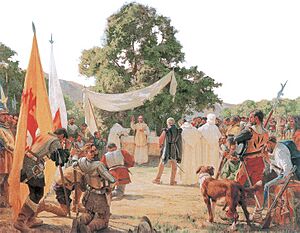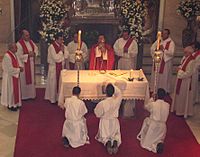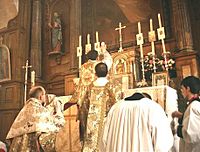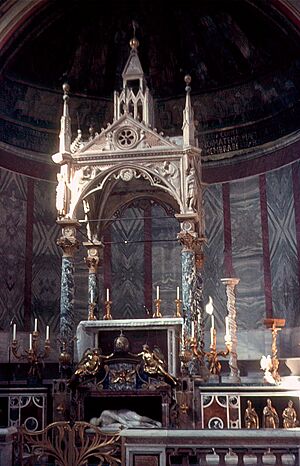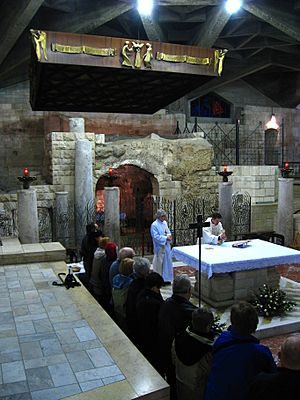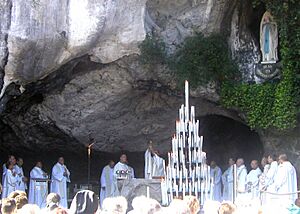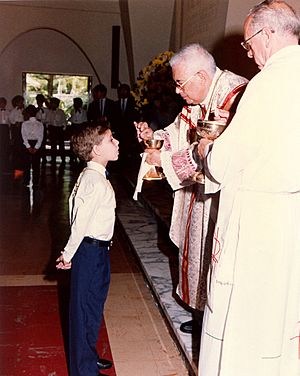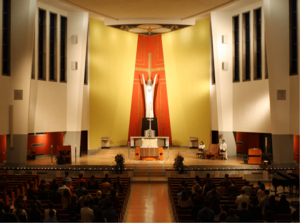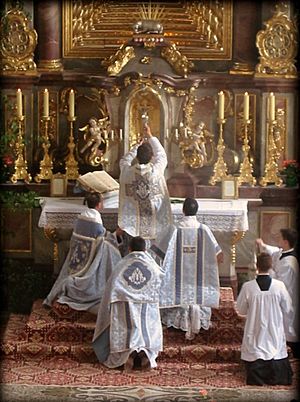Mass in the Catholic Church facts for kids
The Mass is the main worship service of the Catholic Church. During Mass, bread and wine are specially blessed. Catholics believe they become the body and blood of Jesus Christ. The Church teaches that Mass is a sacrifice. It makes Christ's sacrifice on the cross at Calvary truly present again on the altar. Only baptized Catholics who are in a good spiritual state (not in mortal sin) can receive Christ in the Eucharist.
Many other important Catholic ceremonies, like Confirmation and Holy Matrimony, usually happen during Mass today. The word Mass is mostly used for the Latin Church. Other Eastern Catholic churches use different names, like Divine Liturgy. There are different ways Mass can be celebrated. One common way was set by Pope Paul VI after the Second Vatican Council. Another older way, called the Tridentine Mass, can also be used in certain situations.
The word "Mass" comes from the Latin phrase "Ite, missa est". This means "Go, it is the dismissal." Over time, "dismissal" came to mean sending people out on a mission.
Contents
What is the Mass?
The Mass as a Sacrifice
Catholics believe the Mass is a special sacrifice. It brings to life again the one sacrifice of Jesus on the cross. Jesus earned all good things and blessings for us when he died. These blessings help our spiritual life grow. Jesus also created ways for us to receive these blessings. These ways are the Mass and the other sacraments.
The first Mass was started by Jesus at the Last Supper. This happened on the first Holy Thursday. The Last Supper was a way to remember Jesus' sacrifice on the cross. So, the Mass connects the Last Supper with Jesus' death on Calvary.
The Mass has four key parts of a true sacrifice:
- Priest: Jesus Christ is the main priest. An earthly priest helps him.
- Victim: Jesus Christ himself is the victim. He is truly present as bread and wine.
- Altar: This is where the sacrifice takes place.
- Sacrifice: It is a special way to remember Christ's death.
The Mass is offered for four reasons: to worship God, to make up for sins, to give thanks, and to ask for things.
How the Mass Started
The Mass has a long history. Early Christians shared meals together. These meals became linked to the Last Supper. Later, in the second and third centuries, these gatherings became more formal. They included reading from the Bible. The use of bread and wine became a separate part, not a full meal.
When Christianity became a legal religion, celebrations became more formal. Priests wore special clothes. Lights and incense were used. Prayers became set texts, approved by bishops. This led to different "rites" or ways of celebrating. These rites were often linked to important church cities.
The Catholic Church has many different ways of celebrating Mass. Besides the main Latin way, there are Eastern Catholic ways. These include the Byzantine Rite, Alexandrian Rite, Antiochene Rite, East Syriac Rite, and Armenian Rite. Each has its own traditions and languages.
Mass in the Roman Rite
The Roman Rite Mass is the most common way Mass is celebrated in the Latin Church. Its history includes older forms before the Council of Trent. Then came the Tridentine Mass. Finally, there is the post-Vatican II Mass.
After the Council of Trent (1545–1563), Pope Pius V made the Tridentine Mass the standard. This was in 1570. Before this, many local areas had their own ways of celebrating Mass. Pope Pius V allowed older rites to continue only if they had been used for at least 200 years.
The Second Vatican Council (1962–65) asked for changes to the Roman Missal. Pope Paul VI put these changes into effect in 1969.
Modern Roman Rite Mass
Today, the Mass is usually celebrated in the local language. This is the form requested by the Second Vatican Council. It was set by Pope Paul VI in 1969 and updated by Pope John Paul II in 2002. This form largely replaced the older Tridentine Mass. The 1962 Tridentine Mass, in Latin, can still be used in certain situations.
In the modern Mass, the priest usually faces the people. In the older form, the priest often faced the same direction as the people, towards the church's altar area.
Liturgical Books
The Roman Missal contains the prayers, songs, and rules for Mass.
The Lectionary has Bible readings for each day's Mass. It has many more readings than older versions. A separate Gospel Book is used for the Gospel reading.
Other books, like the Ceremonial of Bishops, give rules for when a bishop celebrates Mass. There are also special guidelines for Masses with children.
How Mass is Structured
The Mass is one act of worship. It has different parts. These always include:
- Reading from the Bible.
- Giving thanks to God.
- Blessing the bread and wine.
- Receiving Communion.
Within the Mass structure, some parts change daily. These include the Bible readings, certain prayers, and songs. These parts follow the church calendar. They reflect different seasons or feast days.
Introductory Rites
The priest and altar servers enter the church. A deacon might carry the Gospel book. A server carries a cross. Others might carry candles or incense. A song is usually sung during this procession. If there is no singing, a special prayer is said.
When they reach the altar, everyone bows. The priest and other ministers kiss the altar. The priest then leads everyone in making the Sign of the Cross. He says: "In the name of the Father, and of the Son, and of the Holy Spirit." Everyone answers: "Amen." The priest then greets the people. These greetings come from the Bible.
Next, the priest invites everyone to the Penitential Act. This is a time to remember our sins. The Missal offers three ways to do this. One way is the Confiteor. The priest ends with a prayer that forgives venial sins. Sometimes, especially during Easter, holy water is sprinkled instead. This reminds people of their Baptism. This is called the Asperges.
After the Penitential Act, the "Kyrie, Eleison" (Lord, have mercy) is always said or sung. This is a prayer where people ask for God's mercy. It can be in the local language or in Greek. It is the only part of the Mass that can be in Greek.
The "Gloria in Excelsis" (Glory to God in the highest) is an old and important hymn. The Church sings it to praise God the Father and Jesus. It is sung on Sundays (except during Advent and Lent) and on special feast days. It is not sung at funerals or on regular weekdays.
Then the priest asks everyone to pray. There is a short silence for people to think of their intentions. The priest then says a prayer called the "Collect". This prayer sets the theme for the celebration.
Liturgy of the Word
On Sundays and special days, three Bible readings are given. On other days, there are two. The first reading is usually from the Old Testament. This is followed by a Responsorial Psalm. A singer or choir leads, and everyone sings or says a response. The second reading is from the New Testament, often from a letter of Saint Paul. The reader ends by saying "The word of the Lord." The people respond "Thanks be to God."
The most important reading is the Gospel. This is read by a deacon or a priest. Before the Gospel, everyone stands and sings an Alleluia. During Lent, a different song is used. The Gospel reading ends with "The Gospel of the Lord." The people respond "Praise to you, Lord Jesus Christ." The priest or deacon then kisses the book.
On Sundays and special holy days, a homily is given. This is a talk that explains the readings or the Mass. The priest usually gives the homily. It is never given by someone who is not a priest or deacon. On other days, a homily is not required but is suggested.
On Sundays and solemnities, everyone says or sings the Nicene Creed. This is a statement of Christian faith. The Apostles' Creed can also be used, especially during Easter or for Masses with children.
The Liturgy of the Word ends with the Universal Prayer. This is also called the Prayer of the Faithful. The priest introduces it. Then someone announces prayers for different needs. Everyone responds with a short prayer like "Lord, hear our prayer." The priest finishes with a longer prayer.
Liturgy of the Eucharist
Preparation of the Gifts
A special cloth called a corporal is spread on the altar. The Liturgy of the Eucharist begins with placing bread and wine on it. These may be brought forward in a procession. The unleavened bread is placed on a paten. The wine is put in a chalice with a little water. The priest says a silent prayer over each. If there is no singing, he can say these prayers aloud. The people respond: "Blessed be God forever." The priest then washes his hands. This shows a desire for inner cleansing.
The people stand up. The priest asks them to pray: "Pray, brethren, that my sacrifice and yours may be acceptable to God, the almighty Father." The people respond: "May the Lord accept the sacrifice at your hands, for the praise and glory of his name, for our good, and the good of all his holy Church." The priest then says a special prayer over the gifts.
Eucharistic Prayer
The Eucharistic Prayer is the most important part of the Mass. It begins with a conversation between the priest and the people. The priest says: "The Lord be with you." Then he says: "Lift up your hearts." The people respond: "We lift them up to the Lord." The priest then says: "Let us give thanks to the Lord, our God." The people agree, saying: "It is right and just."
The priest continues with a special introduction to the Eucharistic Prayer. This leads to the "Sanctus" (Holy, Holy, Holy) song: "Holy, Holy, Holy Lord God of hosts. Heaven and earth are full of your glory. Hosanna in the highest. Blessed is he who comes in the name of the Lord. Hosanna in the highest."
In some places, people kneel after the Sanctus. The priest then says the words Jesus said at the Last Supper. He recalls Jesus' actions: "Take this, all of you, and eat of it: for this is my body which will be given up for you. ...Take this, all of you, and drink from it: for this is the chalice of my blood, the blood of the new and eternal covenant, which will be poured out for you and for many for the forgiveness of sins. Do this in memory of me." A bell is often rung after the priest lifts the bread and wine. This is so people can see them. The priest then says: "The mystery of faith." The people respond with a special prayer.
The Eucharistic Prayer includes a prayer called the Epiclesis. This asks the Holy Spirit to change the bread and wine. It also asks for the people to be changed into one body in Christ. The part that remembers Christ's passion, death, and resurrection is called the Anamnesis.
Prayers for living people and for souls in Purgatory follow. Priests who are helping to celebrate Mass join in these prayers.
The Eucharistic Prayer ends with a strong prayer of praise called a doxology. The priest lifts the bread and wine. He says: "through him, with him, in him, in the unity of the Holy spirit, all glory and honor is yours, Almighty Father, for ever and ever." The people sing or say a loud "Amen." This "Amen" shows that people agree with all that God has done.
Communion Rite
The Communion Rite starts with the "Our Father". The priest invites everyone to pray it together. The priest then adds a prayer called the embolism: "Deliver us, Lord, we pray, from every evil..." The people then say: "For the kingdom, the power, and the glory are yours, now and forever."
During the "Our Father," the priest usually holds his hands out. Some people in the congregation also hold hands or hold their hands out. However, the Church does not require people to do this.
The Rite of Peace is the next part. The priest prays for peace. Then he wishes the people the peace of Christ: "The peace of the Lord be with you always." A deacon or the priest then invites people to offer each other a sign of peace. This can be a handshake or a bow.
The third part is the breaking of the bread. The priest breaks the blessed bread. He places a piece into the wine. This shows that Christ's Body and Blood are together. While this happens, the "Lamb of God" ("Agnus Dei" in Latin) is sung or said.
The priest then shows the blessed bread to the people. He says: "Behold the Lamb of God... Blessed are those who are called to the supper of the Lamb." Everyone responds: "Lord, I am not worthy that you should enter under my roof, but only say the word and my soul shall be healed." This comes from a story in the Bible about a Roman soldier. The priest then receives Communion. Other ministers help distribute Communion to the people.
The Catholic Church teaches that receiving Holy Communion while in mortal sin is wrong. Only those who are in a state of grace (without mortal sin) can receive it. If someone has committed a mortal sin, they should go to Confession first.
People receive Communion kneeling or standing, depending on local rules. In many places, people can receive the blessed bread on their tongue or in their hand. If they receive it in their hand, they should eat it right away.
While Communion is given out, a song is usually sung. This helps show that everyone is part of Christ's body. After Communion, the priest or deacon cleans the sacred vessels. The priest then ends the Liturgy of the Eucharist with a final prayer.
Concluding Rite
After the final prayer, short announcements might be made. The priest then gives a blessing. The Mass ends with a conversation between the priest and the people. The deacon or priest dismisses the people. The people respond: "Thanks be to God." The priest and ministers then bow to the altar and leave. A song is often sung as they leave.
After Mass, people can leave or stay to pray. In some countries, the priest greets people as they leave the church.
When Mass is Celebrated
Mass can be celebrated at almost any time. However, on Good Friday, Mass is not celebrated. Instead, there is a special service. On Holy Saturday, Mass is not celebrated before the Easter Vigil. The Easter Vigil is the start of Easter Sunday.
Priests are encouraged to celebrate Mass often, even daily. Usually, a priest can only celebrate Mass once a day. But there are some exceptions. A priest usually needs at least one other person present to celebrate Mass.
Priests who are in charge of parishes must celebrate Mass for their people on Sundays and Holy Days of Obligation.
For Latin Church priests, there are a few times they can celebrate Mass more than once:
- On Christmas Day, they can celebrate Mass three times. Each Mass has different readings.
- On All Souls' Day, they can also celebrate Mass three times. One Mass can be for their own intentions. The other two must be for all who have died and for the Pope's intentions.
- A priest who celebrates the Chrism Mass on Holy Thursday morning can also celebrate the Mass of the Lord's Supper that evening.
- A priest can celebrate both the Easter Vigil Mass and Easter Sunday Mass.
- If a priest has celebrated Mass at a meeting, he can celebrate a second Mass for the people.
Bishops can also allow priests to celebrate Mass twice on weekdays. They can allow three times on Sundays and Holy Days. This helps if a priest needs to say a regular daily Mass and a funeral Mass. Or if a parish is very large and needs many Masses on Sundays. In very difficult situations, the Pope can allow priests to celebrate Mass three times on weekdays and four times on Sundays.
In many countries, it is common for priests to celebrate at least two Masses on Sundays. They might also celebrate two Masses on other days.
How Long Mass Lasts
The time it takes to celebrate Mass can vary a lot. A solemn Mass might take over an hour and a half. The length of the homily affects the time. The number of people receiving Communion and the amount of singing also play a role.
In the past, Mass was often shorter. Before the 1900s, it was common for only the priest to receive Communion. Some people thought Mass should be no longer than half an hour. Others said it should be at least twenty minutes. Some even said that finishing Mass in less than fifteen minutes could be a serious sin.
Special Masses
Ritual Masses
A Mass celebrated with another special ceremony is called a Ritual Mass. This includes Masses for an ordination, a wedding, or religious vows. These Masses use special texts from the Roman Missal. Most often, the ceremony is a sacrament. There are special texts for Masses with Baptism, Confirmation, Anointing of the Sick, Holy Orders, and Matrimony. There are also texts for religious profession and the dedication of a church. Confession is the only sacrament not celebrated during Mass.
Ritual Mass texts usually cannot be used during very important church seasons or on high feast days.
A Nuptial Mass is a Ritual Mass where the sacrament of matrimony is celebrated. It has special prayers for the couple. It can be offered at any time of the year, except during the Paschal Triduum.
Mass Intentions
It is common for Mass to be celebrated for a special reason. This reason is called a Mass intention. People might give a donation to the priest for a specific intention. This is called a Mass stipend. Church law says that a priest can accept an offering to celebrate Mass for a certain intention.
See also
 In Spanish: Misa para niños
In Spanish: Misa para niños


